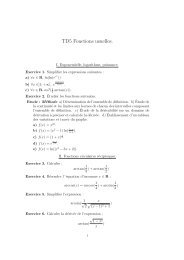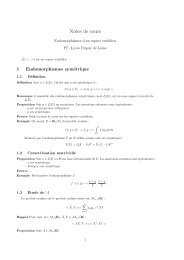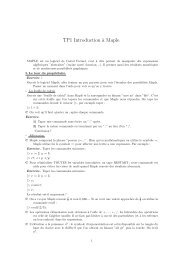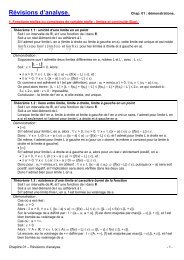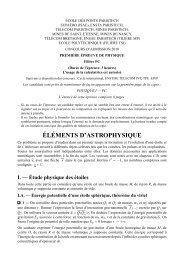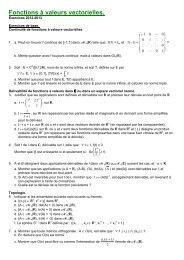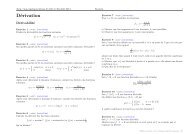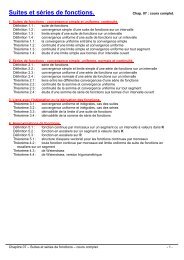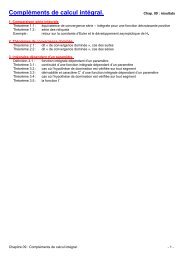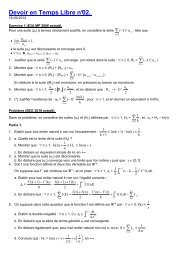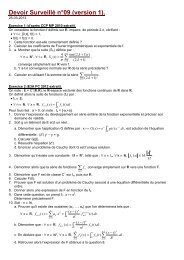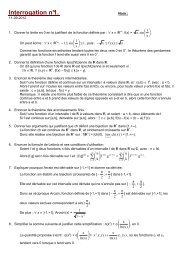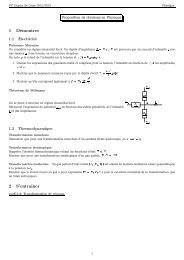[http://mp.cpgedupuydelome.fr] édité le 4 juin 2013 Enoncés 1 ...
[http://mp.cpgedupuydelome.fr] édité le 4 juin 2013 Enoncés 1 ...
[http://mp.cpgedupuydelome.fr] édité le 4 juin 2013 Enoncés 1 ...
Create successful ePaper yourself
Turn your PDF publications into a flip-book with our unique Google optimized e-Paper software.
[<strong>http</strong>://<strong>mp</strong>.<strong>cpgedupuydelome</strong>.<strong>fr</strong>] <strong>édité</strong> <strong>le</strong> 26 juil<strong>le</strong>t <strong>2013</strong> Corrections 91<br />
Puisque det A = αβ = 1, on a α = 1/β = ¯ β/ |β| 2 = ¯ β.<br />
Enfin, trA = 2Re(α) ∈ Z et 2Re(α) ∈ [−2, 2] car |α| 1 donc |Re(α)| ∈ {0, 1/2, 1}.<br />
c) Selon la va<strong>le</strong>ur de Re(α) et sachant |α| = 1, <strong>le</strong>s va<strong>le</strong>urs possib<strong>le</strong>s de α sont<br />
−1, j, i, −j 2 , 1<br />
et <strong>le</strong>urs conjuguées.<br />
Dans tous <strong>le</strong>s cas, on vérifie α 12 = 1 et on a aussi β 12 = 1.<br />
Puisque A est semblab<strong>le</strong> à la matrice diagona<strong>le</strong> D = diag(α, β) et que cel<strong>le</strong>-ci<br />
vérifie D 12 = I2, on a A 12 = I2.<br />
d) On vérifie aisément que G est un sous-groupe du groupe (GL2(C), ×) et puisque<br />
G = I2, A, A 2 , . . . , A 11<br />
G est un groupe monogène fini.<br />
II) a) Le changement de variab<strong>le</strong>s proposé a pour jacobien<br />
D(x, y)<br />
D(r, θ) =<br />
<br />
<br />
<br />
a cos θ −ar sin θ <br />
<br />
b sin θ br cos θ = abr<br />
Ce changement de variab<strong>le</strong> donne<br />
2π 1 2 2 2 2 2 2<br />
I =<br />
a r cos θ + b r sin θ × |abr| dr dθ<br />
et donc<br />
0<br />
r=0<br />
I = πab(a2 + b2 )<br />
4<br />
b) Par <strong>le</strong> paramétrage direct<br />
<br />
x(t) = a cos t<br />
avec t ∈ [0, 2π]<br />
y(t) = b sin t<br />
on obtient<br />
puis au terme des calculs<br />
c) On observe<br />
2π<br />
J = −<br />
0<br />
ab 3 sin 4 θ + a 3 b cos 4 θ dθ<br />
J = − 3πab(a2 + b 2 )<br />
4<br />
J = −3I<br />
ce qui est conforme à la formu<strong>le</strong> de Green Riemann puisque<br />
y 3 dx − x 3 dy = P (x, y) dx + Q(x, y) dy<br />
avec<br />
∂Q ∂P<br />
(x, y) −<br />
∂x ∂y (x, y) = −3(x2 + y 2 )<br />
Exercice 153 : [énoncé]<br />
I) a) Posons n = dim E, p = dim A.<br />
Soit (e1, . . . , ep) une base orthonorma<strong>le</strong> de A. On peut la co<strong>mp</strong>léter en en<br />
(e1, . . . , en) base orthonorma<strong>le</strong> de E.<br />
Puisque A = Vect(e1, . . . , ep), on a l’équiva<strong>le</strong>nce<br />
et donc A ⊥ = Vect(ep+1, . . . , en) puis<br />
x ∈ A ⊥ ⇔ ∀i ∈ {1, . . . , p} , (ei | x) = 0<br />
E = A ⊕ A ⊥<br />
b) On a dim A ⊥ = n − dim A et donc dim A ⊥ ⊥ = dim A.<br />
Or on a aussi<br />
A ⊂ A ⊥⊥<br />
car<br />
∀x ∈ A, ∀y ∈ A ⊥ , (x | y) = 0<br />
donc par inclusion et égalité des dimensions, on obtient<br />
II) a) Posons<br />
Puisque<br />
A ⊥ ⊥ = A<br />
P (x, y) = xy − y 2 + 1 et Q(x, y) = x 2 − xy − 1<br />
∂Q<br />
∂x<br />
= ∂P<br />
∂y<br />
la forme différentiel<strong>le</strong> ω n’est pas fermée.<br />
b) La forme différentiel<strong>le</strong><br />
θ(x, y) = ω(x, y)f(xy)<br />
est de classe C 1 sur l’ouvert étoilé R 2 , el<strong>le</strong> est donc exacte si, et seu<strong>le</strong>ment si, el<strong>le</strong><br />
est fermée. Cela équivaut à la satisfaction pour tout (x, y) ∈ R 2 de l’équation<br />
(2x − y)f(xy) + y(x 2 − xy − 1)f ′ (xy) = (2y − x)f(xy) + x(xy − y 2 + 1)f ′ (xy)<br />
Après si<strong>mp</strong>lification, on obtient<br />
(x + y) (f(xy) − f ′ (xy)) = 0<br />
Diffusion autorisée à titre entièrement gratuit uniquement - dD


![[http://mp.cpgedupuydelome.fr] édité le 4 juin 2013 Enoncés 1 ...](https://img.yumpu.com/19249082/91/500x640/http-mpcpgedupuydelomefr-edite-le-4-juin-2013-enonces-1-.jpg)
